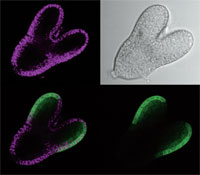
National Institute for Basic Biology





(Written in 2012)
Plant organs - leaves, flowers, and roots - show impressive, symmetrical shapes, based on an ordered arrangement of differentiated cells. The organs are formed from a group of undifferentiated cells located at the tip of the stem or the root. In the case of leaves, the process of organogenesis starts with the formation of a leaf primordium in the peripheral zone of the shoot apical meristem at the fixed position, following an order called phyllotaxis. Cells in the primordium then proliferate and differentiate according to three spatially fixed axes: the apical-basal axis, the lateral axis (central-marginal axis), and the adaxial-abaxial (foreside-backside) axis. In the course of proliferation and differentiation, the plant cells are believed to exchange information with neighboring or separated cells in order to regulate the organ architecture. We are trying to understand the mechanism of the information exchange between plant cells during the development of lateral organs, such as leaves, sepals, petals, stamens and carpels.

Figure 1. Region-specific expression of the FIL gene at the abaxial sideregion of the developing cotyledons of Arabidopsis at the late heart stage embryo. Top right: light-field microscope picture. Top left: Pink signal show auto-fluorescence of chloroplasts. Bottom right: Green signals show the FIL promoter-drived green fluorescence protein (GFP). Bottom left: Merged picture of chloroplast auto-fluorescence and of GFP.
Yoshida, Y., Sano, R., Wada, T., Takabayashi, J., and Okada, K. (2009). Jasmonic acid control of GLABRA3 links inducible defense and trichome patternning in Arabidopsis. Development 136, 1039-1048.
Nishimura, T., Wada, T., Yamamoto, K.T., and Okada, K. (2005). The Arabidopsis STV1 protein, responsible for translation reinitiation, is required for auxin-mediated gynoecium patterning. Plant Cell 17, 2940-2953.
Watanabe, K., and Okada, K. (2003). Two discrete cis elements control the Abaxial side-specific expression of the FILAMENTOUS FLOWER gene in Arabidopsis. Plant Cell 15, 2592-2602.
Matsumoto, N., and Okada, K. (2001). A homeobox gene, PRESSED FLOWER, regulates lateral axis-dependent development of Arabidopsis flowers. Genes Dev. 15, 3355-3364.
Sawa, S., Watanabe, K., Goto, K., Liu, Y.G., Shibata, D., Kanaya, E., Morita, E.H., and Okada, K. (1999). FILAMENTOUS FLOWER, a meristem and organ identity gene of Arabidopsis, encodes a protein with a zinc finger and HMG-related domains. Genes Dev. 13, 1079-1088.